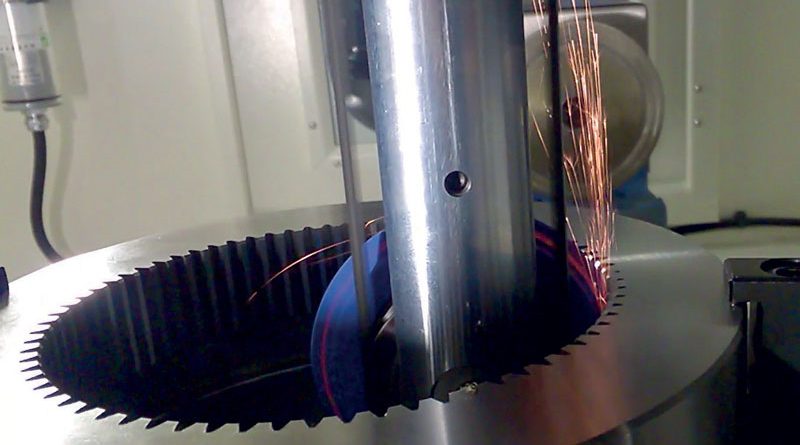Automating Gear Production
NUM is helping Taiwanese specialist of CNC gear grinding machines automate production of involute and cycloidal gears for robotics. The unique multi profile capability offered by the machine control offers the ability and flexibility to produce to manufacture both cycloid and involute gears on the same machine, thus increasing manufacturing productivity.
by Elena Magistretti
NUM is helping the Taiwanese machine tool company Chien Wei Precise Technology to develop innovative CNC grinding machines for manufacturing specialist gears used in robotics applications.
Based entirely on NUM’s latest-generation Flexium+ 68 CNC platform, Chien Wei’s new machines are designed to speed the production of both involute and cycloidal profile precision gears. They are believed to be the first gear grinding machines on the market that are capable of handling both types of gear profile. There are two versions of the grinding machine, one for internal gears, the other for external gears.
The gear units used in robotic systems
Robotic systems typically use either planetary gear units equipped with involute gears, or cycloid drives based on a combination of a reduced epitrochoid rotor and a cycloid stator. While planetary gearboxes have been around for a long time and enjoy extensive use, cycloid drives have far fewer moving parts and offer a more efficient means of achieving extremely high reduction rates. A speed reducer with a ratio of 200:1 would typically need a chain of three planetary gear boxes with twelve moving involute gears.
The same reduction ratio could be achieved with a cycloid drive using one stator and one rotor. However, cycloid gears are notoriously difficult and expensive to manufacture.
In 2015, Chien Wei decided to bring gear manufacturing in-house, by developing its own gear grinding machine.
By producing its own gear units the company could control quality, shorten lead times and reduce costs. It would also enable it to sell gearboxes to machine builders, and possibly the machines themselves to gear manufacturers.
Production of both cycloid and involute gears on the same machine
Chien Wei initially based its gear grinding machine on a Fanuc series 0i-MF CNC system, which it uses for other machine tools, together with Mastercam CAD/CAM software and its own CMM.
But it soon became apparent that the profile complexity of cycloidal gears meant that CMM data was inadequate for controlling the manufacturing process. Another major disadvantage was that customers wishing to purchase the machines would also need to invest in an expensive CAD/CAM system and extra personnel.
The CNC system which was chosen can fully support gear grinding from the outset, so that customers can simply input the parameters of the gear they want, with the CNC then controlling all aspects of the machine’s dressing and grinding processes in real-time.
NUM was an obvious choice, because of its proven expertise in CNC gear grinding applications. The company was also willing to collaborate in the joint development of the CNC system, which includes an application-specific HMI (human-machine interface) and various dedicated control functions.
The new generation of Chien Wei’s gear grinders together with NUM’s new profile grinding technology now provides the ability and flexibility to manufacture both cycloid and involute gears on the same machine.
Construction features of external and internal grinders
Chien Wei’s internal gear grinder is a 9-axis machine. The work piece table is mounted on a linear axis that moves axially towards the grinding wheel, which is belt-driven (due to space constraints inside the gear) and mounted on a vertical axis driven by a linear motor.
As the grinding wheel spins, it is driven up and down by the linear axis, while the work piece table moves in continuously. Both flanks of the gear are ground simultaneously. The machine also handles gear dressing. During the dressing cycle, the entire tool head is moved horizontally to the right, and a symmetrical dressing disk moves along the outer shape of the grinding wheel in three sections, right/left flank and tip. Cycloids as well as involute shapes can be dressed.
The external gear grinder is an 8-axis machine. Broadly similar to the internal gear grinder in operational terms, it features a direct drive grinding wheel. Again, like the internal gear grinder, it also handles dressing. However, in this case the shape of the tooth gap can be reduced epitrochoids or involutes.
Manual correction of the gear tooth shapes is possible on either machine. Both machines are controlled by NUM Flexium+ 68 CNC systems, equipped with NUM FS153i touch-sensitive operating panels. The application-specific HMI that has been jointly developed by NUM Taiwan and Chien Wei controls both the grinding and dressing cycles, and allows users to fully specify the required gear profile simply by entering the appropriate parameters. Graphical DXF (Drawing Interchange Format) files can be imported from – and exported to – CAD systems, and the system features a comprehensive database for grinding wheels and work pieces. The NC programs are generated entirely automatically, without any need for operator involvement.

